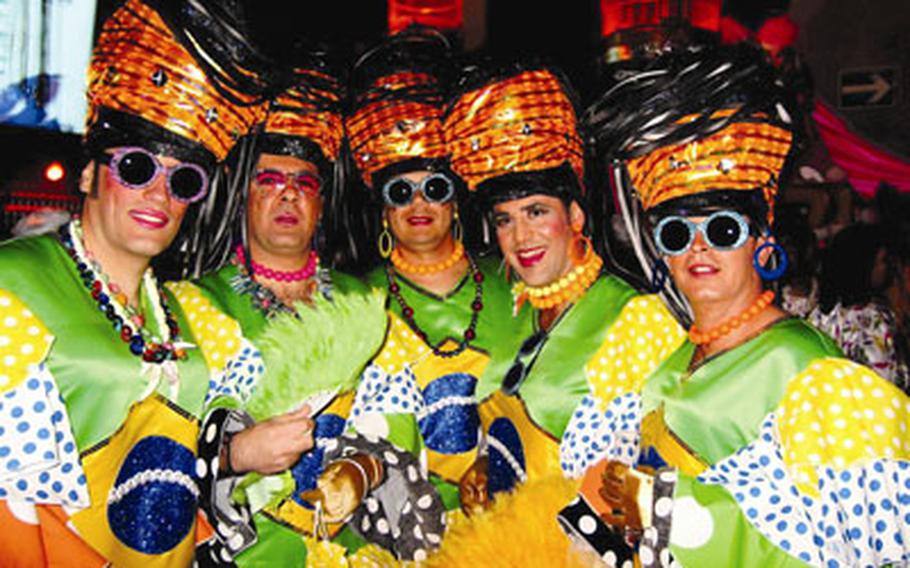
Gaily dressed performers take a break from one of Las Palmas’ wild street parties, known as “Mogollons,” to pose for a photo during the island’s carnival celebration. (Photos by Skip Kaltenheuser/Special to Stars and Stripes)
Click here for a list of carnival events
Carnival in the Canary Islands is an exuberant mix of good weather and good times.
The climate is a pleasure on this cluster of islands that belongs to Spain but is located off the coast of Africa. Revelers from Europe — plus a smattering of Americans — arrive by planeloads to indulge in the sun and carnival fun.
While carnival is celebrated in towns across the islands, the largest events are on Tenerife and Gran Canaria, two of the biggest islands. They attract carnival "delegations" — groups of performers from abroad — along with the spectators, all feeling free to cut loose during three weeks of festivities.
Warm-up events include several nights of lively music and the selection of carnival queens — and drag queens.
The selection and coronation of the official carnival queen is an all-night, televised affair with elaborate dresses and great spectacle. As for the drag queens, cross-dressing is a venerable tradition in much of Europe, but on Gran Canaria the drag contest has reached P.T. Barnum magnitude. On the night of the queen’s selection, carnival is at its wildest.
In Tenerife, I spent two nights immersed in the music, dancing and entertainment of the open-air parties that begin at about 11 p.m. and continue until daylight. They serve as a prelude for the big Rose Monday parade at Santa Cruz de Tenerife.
The staging area for the parade is like backstage at a circus. The procession is a swirl of colorful costumes and fetching females parading to infectious music amid blooming African tulip trees and ocean breezes. The evening finishes with another huge concert.
I then migrated to Gran Canaria, known as "the little continent" for its variety of landscapes and cultural offerings, and made it to Las Palmas, famed for its all-night carnival street parties known as "Mogollons." They are the highlight of what organizers claim is the biggest carnival on the islands.
On the final day, I found my way onto a party float in the parade of "mourning" for "the burial of the sardine" — a ritual that brings festivities to an end. A huge papier-mâché sardine is carried through the streets, followed by weeping "widows," local men dressed in black miniskirts and fishnet stockings, and fake priests bemoaning the conclusion of carnival and the beginning of Lent. The sardine is burned in a bonfire amid a massive fireworks display.
That burning of a scapegoat, whether portrayed as royalty or as an ancient fish deity, is key to many carnivals. It’s a ritual that brings order, and an end, to carnival chaos. It also represents the re-creation of the world, with the sacrifice taking with it all the woes of the prior year and leaving the promise of a fresh start in its place.
That’s a tradition worth celebrating anywhere.
Skip Kaltenheuser is freelance writer who lives in the Washington, D.C., area.